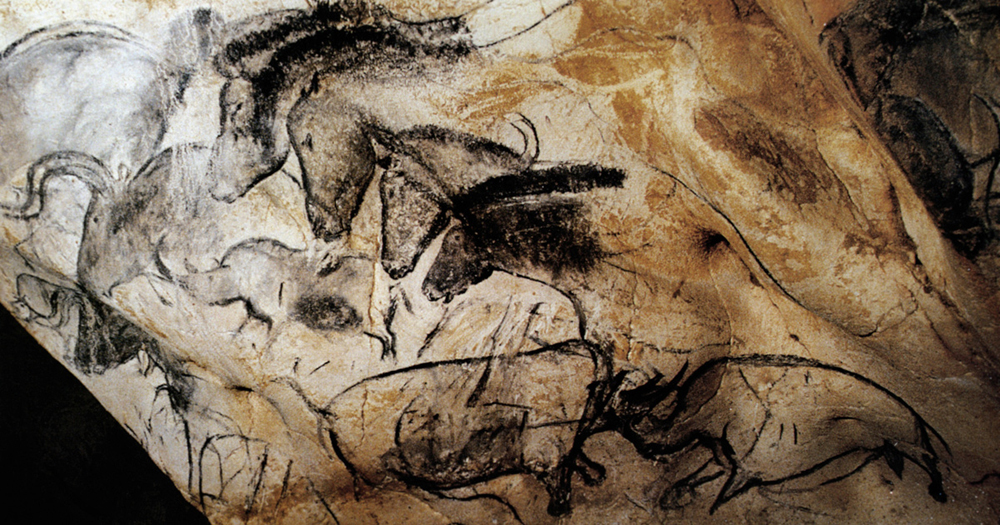


In the search for meaning, let's not lose sight of the artistry.

This panel of rock art in Chauvet is known as the Panel of the Horses, and it comprises some twenty animals. The Aurignacian charcoal drawings are considered to be one of the most outstanding scenes in Chauvet; there are many elements to it.
The scene with the rhinoceroses confronting each other can be seen nowhere else in Palaeolithic rock art. Face to face, and with horns crossed, they represent males fighting. The way the bodies have been drawn, especially the figure on the right which measures roughly 1 meter in length, emphasizes the power of the scene. It is thought they were drawn by the same artist as one composition, roughly 32,000 years ago.
This overall panel was a planned composition, because the surface of the wall was prepared by scraping. The first animals to be drawn were two rhinoceroses, then the stag and two mammoths, followed by the two rhinoceroses facing each other, then several aurochs on the left of the panel, followed by the heads of the four horses - the space had been reserved for them. This demonstrates an awareness of creation from the margins to the centre of the panel. Notice also the diagonal axis of the drawn panel, marked by the alignment of the horse muzzles, in accordance with the nature and orientation of the stone wall itself.
For the horses, the first one was the one on the left, proceeding down to the final one on the right. Again, these are thought to have been drawn by the same artist; they share a likeness as well as the fact that the artistic effect gained from mixing the charcoal with the surface clay produced the same colours and hues. Once completed, the artist highlighted the four horses by scraping the outer edges of the profiles.
And beneath all of the drawings are the bear clawmarks.
Visit the Chauvet section:
http://www.bradshawfoundation.com/chauvet/index.php
by Bradshaw Foundation
Monday 03 February 2025
by Bradshaw Foundation
Friday 09 August 2024
by Bradshaw Foundation
Wednesday 24 July 2024
by Bradshaw Foundation
Monday 30 May 2022
by Bradshaw Foundation
Wednesday 19 January 2022
by Bradshaw Foundation
Thursday 06 January 2022
by Bradshaw Foundation
Tuesday 21 March 2023
by Bradshaw Foundation
Tuesday 07 February 2023
by Bradshaw Foundation
Thursday 19 May 2022
by Bradshaw Foundation
Monday 04 December 2023
by Bradshaw Foundation
Friday 30 June 2023
by Bradshaw Foundation
Thursday 06 April 2023
by Bradshaw Foundation
Friday 14 July 2023
by Bradshaw Foundation
Monday 22 November 2021
by Bradshaw Foundation
Tuesday 12 July 2016
by Bradshaw Foundation
Tuesday 26 November 2024
by Bradshaw Foundation
Monday 27 November 2023
by Bradshaw Foundation
Friday 07 October 2022
by Bradshaw Foundation
Monday 03 February 2025
by Bradshaw Foundation
Friday 09 August 2024
by Bradshaw Foundation
Wednesday 24 July 2024
by Bradshaw Foundation
Monday 30 May 2022
by Bradshaw Foundation
Wednesday 19 January 2022
by Bradshaw Foundation
Thursday 06 January 2022
by Bradshaw Foundation
Tuesday 21 March 2023
by Bradshaw Foundation
Tuesday 07 February 2023
by Bradshaw Foundation
Thursday 19 May 2022
by Bradshaw Foundation
Monday 04 December 2023
by Bradshaw Foundation
Friday 30 June 2023
by Bradshaw Foundation
Thursday 06 April 2023
by Bradshaw Foundation
Friday 14 July 2023
by Bradshaw Foundation
Monday 22 November 2021
by Bradshaw Foundation
Tuesday 12 July 2016
by Bradshaw Foundation
Tuesday 26 November 2024
by Bradshaw Foundation
Monday 27 November 2023
by Bradshaw Foundation
Friday 07 October 2022
by Bradshaw Foundation
Tuesday 19 November 2024
by Bradshaw Foundation
Wednesday 22 May 2024
by Bradshaw Foundation
Friday 10 November 2023
Friend of the Foundation











